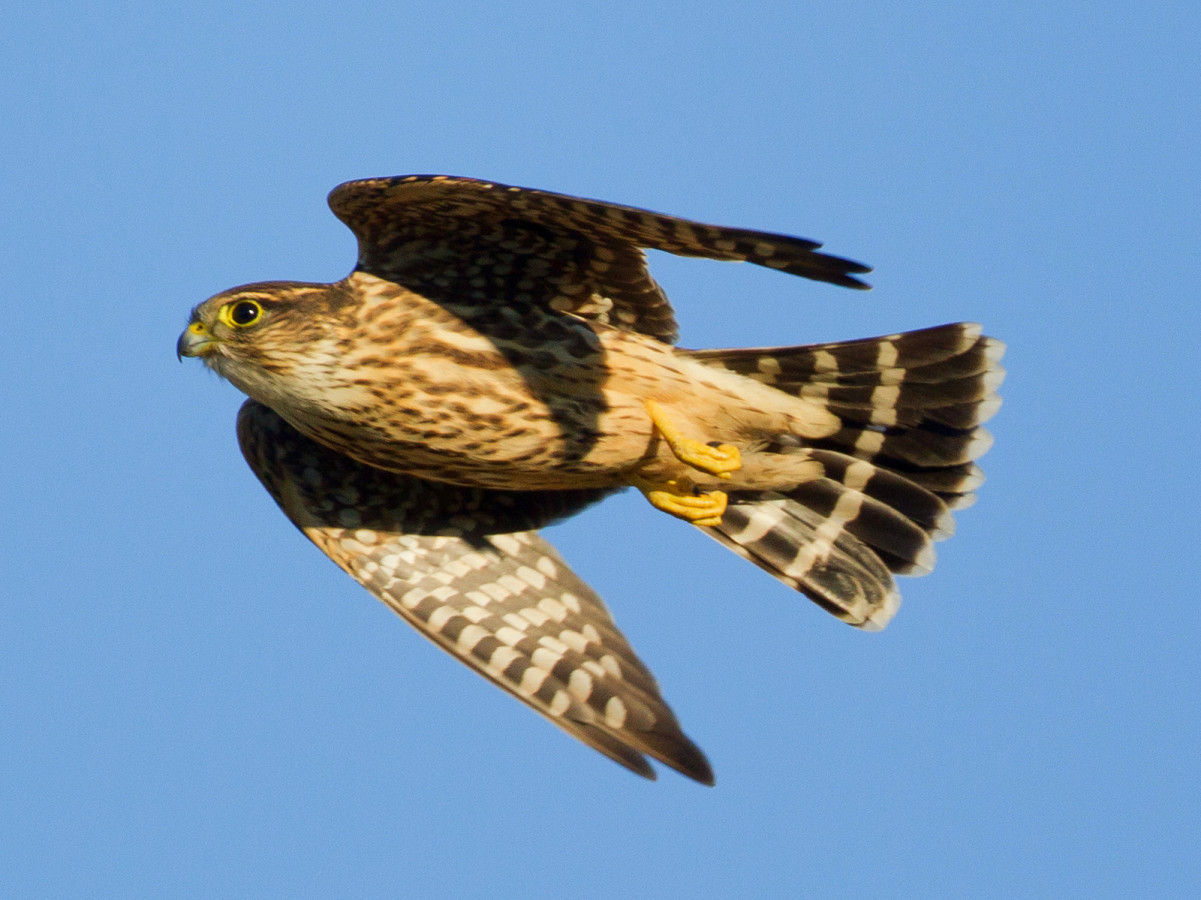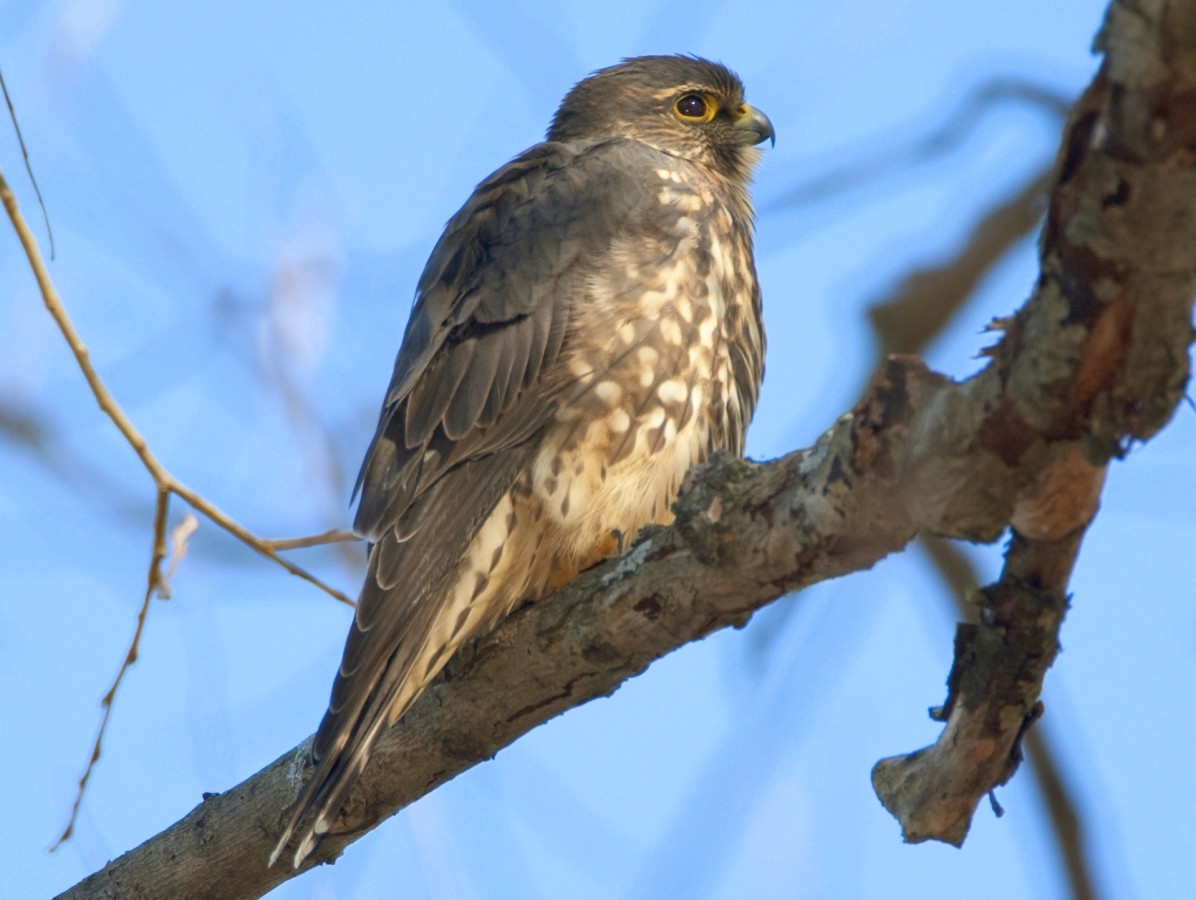The Merlin (Falco columbarius) has had a long and distinguished relationship with humans. Falconry was a cherished pastime of the medieval European aristocracy, and a bird carried on the fist was a conspicuous sign of wealth and sophistication.
According to one popular falconry manual, the Merlin was the perfect bird for a lady; at about a foot long and no more than half a pound in weight, it would certainly have made a handsome, portable accessory for a fashion-conscious noblewoman.
Merlins are a circumpolar species, inhabiting the prairies and boreal forests of the higher latitudes of both Eurasia and North America. There is no evidence that Merlins were ever any more than occasional visitors to New York State, which is situated on the migration route between their historical breeding grounds in Canada and their wintering grounds in the tropics.
Scientists were therefore surprised when breeding Merlins were sighted in the Adirondacks in the 1980s. The birds established themselves in the park very quickly and, from there, spread to the rest of upstate. They now both breed and winter in almost every corner of the state, from Rochester in the north to Buffalo in the west and Binghamton in the south, and have become increasingly common in urban areas.
The reason for this dramatic shift in range is not yet clear. Global climate change is pushing the ranges of many birds northward, but the range of the Merlin is expanding south, against the trend. The landscape of New York has transformed dramatically in the past hundred years as cultivated land has reverted back to forest, a change that has benefited many species. However, because the Merlin catches small songbirds on the wing and so prefers more open habitats, it is not clear that reforestation has been to its benefit. In the nineteenth century, Merlins declined in some parts of their range due to persecution; later, their numbers were again seriously reduced by the widespread use of organochlorine pesticides, including DDT. When these chemicals were banned, Merlin populations rebounded. Yet this still does not explain why there seem to be more Merlins now than ever before.
There is no obvious answer for why Merlins have dispersed so widely around the state. It may be that, for whatever reason, the Merlin population in the north has grown, forcing individuals to colonize new territory further south. Or perhaps a few pioneering birds deviated from their usual migratory route and found that the boreal forests of the Adirondacks were suitable habitat. Bird behavior is far more malleable than most people suspect, and Merlins seem to be a particularly adaptable species.
Scientists have a better idea of why these birds have chosen to breed and winter in cities. Merlins are tolerant of people, able to thrive in many different habitats, and feed on birds that commonly live near human habitation. In the 1970s, Merlins began appearing in cities on the Canadian prairies, apparently attracted by high numbers of Bohemian Waxwings which, in winter, feed from ornamental fruit trees. The city-born birds were much less likely to migrate than others. It is worth noting, however, that the availability of small birds in urban areas has not increased appreciably in recent years; if anything, it has declined.
If small prey items were more common in cities in past decades, why have Merlins only recently moved into urban areas? The most likely explanation is that there has been a dramatic change in human-crow relations over the last thirty years. Merlins do not build their own nests and usually take over abandoned crows’ nests, but until recently, crows have been unwelcome in areas of human settlement. Crow hunting was not regulated in the United States until 1972, the same year that DDT was banned. Around the same time, it became illegal to discharge firearms in many urban areas. Crows are intelligent and curious birds, and they seem to have learned rather quickly that cities were now safe places to live. Parks and cemeteries, which often contain old trees, make particularly attractive nest sites for crows and the Merlins who occupy their old nests.
Merlins are not retiring birds, and are especially noisy when feeding their young. For this reason, they are not difficult to spot, once they have moved in. Appropriately enough, a pair of Merlins—“scrappy little birds,” Andy Zepp called them—nested for several years in a cemetery near the Land Trust office in Ithaca. That pair has since moved on, but Merlins are becoming more visible in the Finger Lakes. In all likelihood, the species’ range will continue to expand and the aerial acrobatics of this intense little falcon, once a sight granted only to a privileged few, will be more and more common with every passing year.



